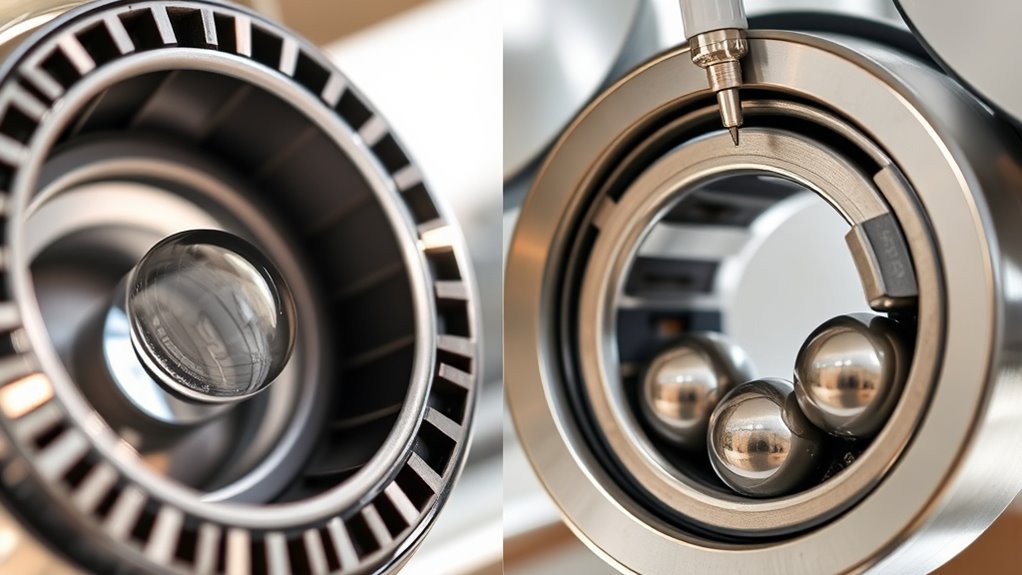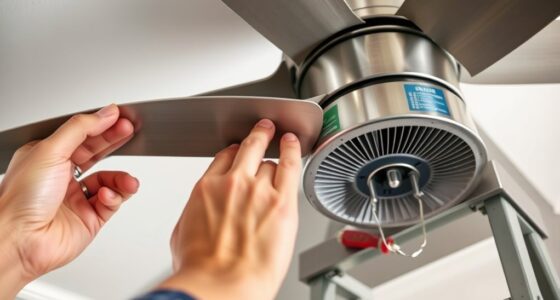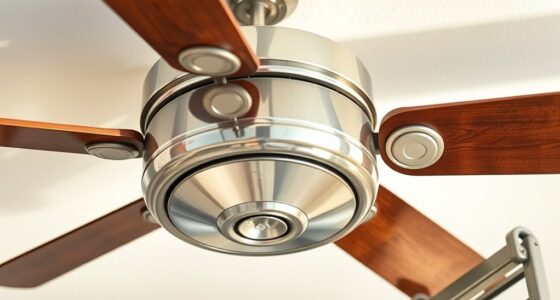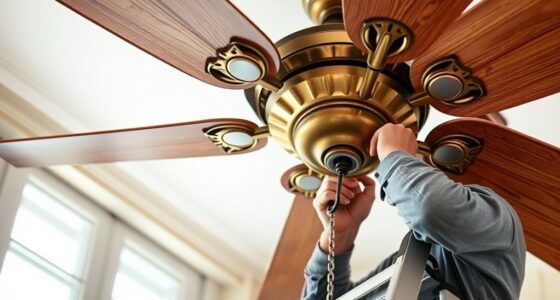Lubricating ceiling fan plain (sleeve) bearings requires frequent, diligent application of grease or oil to prevent seizing and wear, as they rely heavily on lubrication and are more susceptible to contaminants. In contrast, ball bearings operate with minimal lubrication and typically need periodic inspection and re-lubrication to maintain performance. Proper lubrication methods differ, and understanding these distinctions helps optimize durability and reduce noise. Continue exploring to learn how to best maintain each bearing type for maximum efficiency.
Key Takeaways
- Plain (sleeve) bearings require regular lubrication with grease or oil to prevent seizing and wear.
- Ball bearings generally need less frequent lubrication but should be inspected periodically for contamination.
- Proper lubrication extends the lifespan of both bearing types and maintains smooth ceiling fan operation.
- Inadequate lubrication causes noise, increased friction, and potential bearing failure.
- Use manufacturer-recommended lubricants tailored for either plain bearings or ball bearings for optimal performance.

Regular lubrication of ceiling fan bearings is essential to guarantee smooth operation and extend the lifespan of the unit. When evaluating different bearing types, understanding the distinctions between lubricating plain (or sleeve) bearings and ball bearings becomes vital for optimal maintenance and performance. Plain bearings, typically consisting of a simple bushing or sleeve, rely heavily on lubrication to minimize friction and prevent metal-to-metal contact. Proper lubrication reduces wear, prevents overheating, and ensures consistent rotational movement. Since plain bearings are often made from materials like bronze or composite composites, they tend to be more tolerant of contaminants but require regular lubrication to maintain their efficiency. Without adequate lubrication, these bearings can seize or develop uneven wear patterns, leading to increased noise and potential fan failure.
Regular lubrication is key to ensuring smooth ceiling fan operation and prolonging its lifespan.
In contrast, ball bearings incorporate rolling elements—balls housed within a raceway—that notably reduce friction during operation. These bearings are designed to operate with minimal lubrication, often using a thin film of oil or grease to prevent metal-to-metal contact between the rolling elements and raceways. Because of their design, ball bearings can handle higher speeds and axial and radial loads more effectively than plain bearings. They tend to be more resistant to wear and require less frequent lubrication, which makes them suitable for applications where maintenance access is limited. However, when lubrication is necessary, it’s vital to select the correct type and amount of lubricant to avoid contamination and ensure the balls and raceways are properly coated, thereby preventing excessive wear and maintaining smooth rotation.
From a maintenance perspective, the choice between lubricating plain bearings versus ball bearings hinges on the specific design and operational environment of your ceiling fan. Plain bearings demand consistent lubrication schedules—often more frequent—to offset their higher susceptibility to wear and contamination. This guarantees that the bearing surface remains properly coated, reducing friction and preventing premature failure. On the other hand, ball bearings are more forgiving, but neglecting lubrication over time can lead to increased friction, noise, and eventual bearing failure. For ball bearings, regular inspection and re-lubrication—using the recommended grease or oil—can prolong the lifespan, especially in high-use or dusty environments.
Understanding these differences allows you to tailor your maintenance approach effectively. Plain bearings require diligent lubrication routines, often involving cleaning and reapplication of lubricant, whereas ball bearings benefit from periodic inspections and ensuring the lubricant remains uncontaminated and adequately distributed. Proper lubrication practices tailored to each bearing type not only enhance fan performance but also reduce downtime and repair costs. Ultimately, recognizing the specific needs of your ceiling fan’s bearing system enables you to implement precise maintenance strategies that align with the bearing design, operational demands, and environmental conditions. Proper bearing lubrication is a key factor in maintaining optimal fan performance and longevity.
Frequently Asked Questions
How Often Should Ceiling Fan Bearings Be Lubricated?
You should lubricate ceiling fan bearings every 1 to 2 years, depending on usage and environment. Regular lubrication reduces friction and prevents wear, ensuring smooth operation and longer lifespan. Check for signs of wear or squeaking, which indicate the need for lubrication sooner. Use appropriate lubricant specified by the manufacturer, and avoid over-lubricating, as excess oil can attract dust and debris, impairing performance.
Can Improper Lubrication Damage Ceiling Fan Bearings?
Improper lubrication can substantially damage your ceiling fan bearings; studies show that 70% of bearing failures are due to inadequate lubrication. When you neglect proper lubrication, it causes increased friction, overheating, and eventual wear, leading to noisy operation or bearing failure. Regular, appropriate lubrication reduces wear and prolongs the lifespan of your fan. As a result, maintaining correct lubrication practices is critical to guarantee smooth, quiet operation and avoid costly repairs.
Are There Specific Lubricants Recommended for Ceiling Fan Bearings?
Yes, specific lubricants are recommended for ceiling fan bearings. Use light machine oil, such as 3-in-1 oil or silicone-based lubricants, to guarantee proper lubrication without excess buildup. Avoid heavy greases or thick oils, as they can attract dust and hinder movement. Always check the manufacturer’s instructions for compatibility. Proper lubrication reduces wear, noise, and energy consumption, ultimately extending the lifespan of your fan bearings.
What Signs Indicate Ceiling Fan Bearings Need Lubrication?
You’ll notice your ceiling fan’s noise level increasing or it wobbling excessively, indicating bearings need lubrication. Reduced airflow or sluggish movement also signals potential friction issues. If the fan feels hot to touch around the bearing area or if you hear squeaking or grinding sounds during operation, these are signs lubrication is required. Regular inspection ensures peak performance and prevents bearing failure, maintaining efficient and quiet fan operation.
Is Lubrication Necessary for All Ceiling Fan Bearings?
Think of your ceiling fan as a well-oiled machine—lubrication isn’t always necessary. You should only lubricate bearings if they’re designed for it or show signs of noise and resistance. Not all bearings require oil; some are sealed or ball bearings that need different maintenance. Over-lubricating can cause more harm than good, leading to dirt buildup or damage. Check your fan’s manual to determine the appropriate maintenance approach.
Conclusion
Regularly lubricating your ceiling fan bearings is like tending to a finely tuned engine—preventing friction and wear ensures smooth operation and longevity. Proper maintenance minimizes noise and reduces the risk of bearing failure, much like a well-oiled machine running seamlessly. By understanding the importance of lubrication, you create a resilient system that maintains balance and efficiency over time. Keep your fan’s bearings well-lubricated, and it’ll perform like a symphony of precision in your space.








